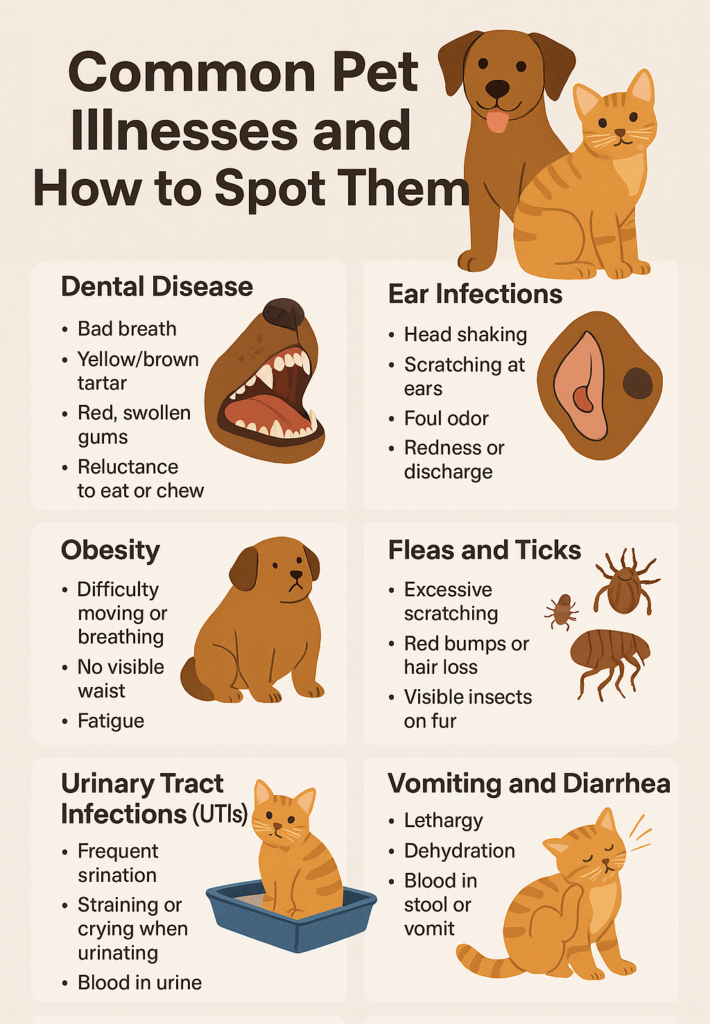Pets can’t tell us when they feel sick, but their bodies do. As loving pet parents, it’s our job to recognize the warning signs. Catching a health issue early can make all the difference—sometimes even saving your pet’s life. This guide will walk you through 10 common pet illnesses, what they are, the symptoms to look for, and what you can do to help.

Table of Contents
🦷 1. Dental Disease
What It Is
A buildup of plaque and bacteria that leads to gum inflammation, tooth loss, and infections.
Symptoms
- Bad breath
- Yellow/brown tartar
- Red, swollen gums
- Reluctance to eat or chew
What You Can Do
Brush your pet’s teeth regularly and schedule yearly vet dental cleanings. Use vet-approved dental treats as part of daily care.
Video: How to Brush your dog’s teeth – AKC Vet’s Corner
👂 2. Ear Infections
What It Is
Bacterial or yeast infections caused by moisture, allergies, or foreign bodies.
Symptoms
- Head shaking
- Scratching the ears
- Foul odor
- Redness or discharge
What You Can Do
Use a gentle ear-cleaning solution recommended by your vet, especially after swimming.
⚖️ 3. Obesity
What It Is
Excess body weight that increases the risk of other diseases.
Symptoms
- Lack of visible waist
- Difficulty moving
- Heavy breathing
- Fatigue
What You Can Do
Control portion sizes, encourage daily exercise, and choose high-quality pet food.
Video: How can I tell if my pet is over or under weight? – VCA Nutrition
🦟 4. Fleas and Ticks
What It Is
External parasites that feed on your pet and spread diseases.
Symptoms
- Excessive scratching
- Red bumps or scabs
- Visible fleas or ticks
What You Can Do
Use flea and tick preventative products year-round. You might also want to read our guide on how to make your home pet-safe and tech-savvy.
Video: How To Check Your Pet For Fleas – VetVid
🐾 5. Urinary Tract Infections (UTIs)
What It Is
Bacterial infection in the bladder or urinary tract.
Symptoms
- Frequent urination
- Straining or crying during urination
- Blood in urine
What You Can Do
Ensure proper hydration, keep litter boxes or potty areas clean, and visit the vet at the first signs. See our guide on first aid for pets for more tips.
🤢 6. Vomiting and Diarrhea
What It Is
Digestive upset that may result from infections, allergies, or toxins.
Symptoms
- Nausea
- Loose stool or vomiting
- Dehydration
- Lethargy
What You Can Do
Keep your pet hydrated and observe for 24 hours. If symptoms persist, visit the vet.
🍬 7. Diabetes
What It Is
A chronic condition where the body can’t regulate blood sugar levels.
Symptoms
- Increased thirst and urination
- Weight loss
- Cloudy eyes (in dogs)
What You Can Do
Administer insulin as prescribed, monitor diet, and schedule regular vet check-ups. Learn about pet health insurance benefits to help manage costs.
Video: Diabetes in CAT’S and DOG’S
🐕 8. Skin Allergies
What It Is
Allergic reactions to food, environmental triggers, or parasites.
Symptoms
- Itching
- Red or inflamed skin
- Hair loss or hot spots
What You Can Do
Work with your vet to find the allergen. Explore hypoallergenic diets and allergy treatments.
🦴 9. Arthritis
What It Is
Joint inflammation that leads to stiffness and pain, especially in senior pets.
Symptoms
- Limping
- Difficulty standing or climbing
- Reduced activity
What You Can Do
Use joint supplements like glucosamine, keep your pet at a healthy weight, and provide orthopedic pet beds.
❤️ 10. Heartworm
What It Is
A serious disease caused by parasitic worms transmitted through mosquito bites.
Symptoms
- Coughing
- Fatigue after exercise
- Weight loss
What You Can Do
Use monthly heartworm prevention, and test annually. Also, check our post on vaccinations and preventive care.
Video: What is heartworm disease and how do pets get it? – KOIN 6
🩺 What to Do When Your Pet Shows Symptoms
- DON’T self-medicate – Common human meds can be toxic.
- Document symptoms – Use a pet health tracker app.
- Visit the vet
🛡️ Preventive Measures for Better Pet Health
- Regular vet checkups
- Vaccinations and parasite control
- Balanced diet and exercise
- Mental stimulation and play
- Pet insurance for emergencies
❓ Common Pet Illnesses – FAQ
How often should I take my pet to the vet?
At least once a year, or more often for seniors or pets with health issues.
Can I tell if my pet has a fever?
Use a pet thermometer. Normal range is 101–102.5°F (38.3–39.2°C).
Are certain breeds more prone to illness?
Yes, breeds like Bulldogs or Persians have genetic conditions. Research before adopting.
Q5: What’s the best way to track my pet’s health?
Use a pet health journal or app.
– Apple: Pet Health Tracker & Reminders
– Android: PetVitality Pet Health Tracker
When is vomiting an emergency?
If vomiting occurs repeatedly in 24 hours or includes blood, see a vet immediately.
💬 Final Thoughts
Your pet depends on you to notice when something isn’t right. By staying informed and proactive, you can catch most common pet illnesses early—and that can make all the difference.
Tell us in the comments: What signs made you realize your pet wasn’t feeling well?
🐶 Want more tips like these? Join our Pawfect Life newsletter for weekly updates from real vets and pet lovers like you.

Passionate about animals and an expert in pet behavior, I created Pawfect Life to help you better understand and care for your companion—whether they have fur, scales, or feathers. Here, I share practical tips and reliable information to ensure a happier, healthier life for your pet. Let’s embark on this journey together! 🐾✨






